Spatial Distribution, Contamination Levels, and Health Risks of Trace Elements in Topsoil along an Urbanization Gradient in the City of Urumqi, China
Abstract
1. Introduction
2. Materials and Methods
2.1. Study Area
2.2. Sample Collection, Preparation, and Analysis
3. Quality Control
4. Contamination Assessment of Trace Elements
5. Health Risk Assessment of Trace Elements
5.1. Exposure Analysis
5.2. Assessment of the Non-Carcinogenic Health Risk
5.3. Assessment of the Carcinogenic Health Risk
6. Results and Discussion
Concentrations of Trace Elements in Soil along an Urbanization Gradient
7. Contamination Assessment of Trace Elements in the Soil along an Urbanization Gradient
8. Non-Carcinogenic Risk of Trace Elements in the Soil along an Urbanization Gradient
9. Carcinogenic Risk of Trace Elements in the Soil along an Urbanization Gradient
10. Conclusions
Author Contributions
Funding
Institutional Review Board Statement
Informed Consent Statement
Data Availability Statement
Conflicts of Interest
References
- Bai, Y.; Wang, M.; Peng, C.; Alatalo, J.M. Impacts of urbanization on the distribution of heavy metals in soils along the Huangpu River, the drinking water source for Shanghai. Environ. Sci. Pollut. Res. 2016, 23, 5222–5231. [Google Scholar] [CrossRef] [PubMed]
- Zhao, H.T.; Li, X.Y. Risk assessment of metals in road-deposited sediment along an urban–rural gradient. Environ. Pollut. 2013, 174, 297–304. [Google Scholar] [CrossRef]
- Hamed, A.; Adel, R.; Abdullah, S.; Mohammad, A.; Munir, A.; Abdulelah, A. Sources, toxicity potential, and human health risk assessment of heavy metals-laden soil and dust of urban and suburban areas as affected by industrial and mining activities. Sci. Rep. 2022, 12, 8972–8989. [Google Scholar]
- De Silva, S.; Ball, A.S.; Huynh, T.; Reichman, S.M. Metal accumulation in roadside soil in Melbourne, Australia: Effect of road age, traffic density and vehicular speed. Environ. Pollut. 2016, 208, 102–109. [Google Scholar] [CrossRef] [PubMed]
- De Oliveira, L.M.; Das, S.; da Silva, E.B.; Gao, P.; Gress, J.; Liu, Y.; Ma, L.Q. Metal concentrations in traditional and herbal teas and their potential risks to human health. Sci. Total Environ. 2018, 633, 649–657. [Google Scholar] [CrossRef]
- Jiang, Y.; Chao, S.; Liu, J.; Yang, Y.; Chen, Y.; Zhang, A.; Cao, H. Source apportionment and health risk assessment of heavy metals in soil for a township in Jiangsu Province, China. Chemosphere 2017, 168, 1658–1668. [Google Scholar] [CrossRef]
- Wu, J.; Lu, J.; Li, L.; Min, X.; Luo, Y. Pollution, ecological-health risks, and sources of heavy metals in soil of the northeastern Qinghai-Tibet Plateau. Chemosphere 2018, 201, 234–242. [Google Scholar] [CrossRef]
- Nabulo, G.; Young, S.D.; Black, C.R. Assessing risk to human health from tropical leafy vegetables grown on contaminated urban soils. Sci. Total Environ. 2010, 408, 5338–5351. [Google Scholar] [CrossRef]
- Doabi, S.A.; Karami, M.; Afyuni, M.; Yeganeh, M. Pollution and health risk assessment of heavy metals in agricultural soil, atmospheric dust and major food crops in Kermanshah province, Iran. Ecotoxicol. Environ. Saf. 2018, 163, 153–164. [Google Scholar] [CrossRef]
- Itoh, H.; Iwasaki, M.; Sawada, N.; Takachi, R.; Kasuga, Y.; Yokoyama, S.; Onuma, H.; Nishimura, H.; Kusama, R.; Yokoyama, K.; et al. Dietary cadmium intake and breast cancer risk in Japanese women: A case-control study. Int. J. Hyg. Environ. Health 2014, 217, 70–77. [Google Scholar] [CrossRef]
- Luo, X.S.; Ding, J.; Xu, B.; Wang, Y.-J.; Li, H.-B.; Yu, S. Incorporating bioaccessibility into human health risk assessments of heavy metals in urban park soils. Sci. Total Environ. 2012, 424, 88–96. [Google Scholar] [CrossRef] [PubMed]
- Zhao, Q.; Wang, Y.; Cao, Y.; Chen, A.; Ren, M.; Ge, Y.; Yu, Z.; Wan, S.; Hu, A.; Bo, Q.; et al. Potential health risks of heavy metals in cultivated topsoil and grain, including correlations with human primary liver, lung and gastric cancer, in Anhui Province, eastern China. Sci. Total Environ. 2014, 470, 340–347. [Google Scholar] [CrossRef] [PubMed]
- Gábor, S.; Ágnes, L.; Veronika, B.; László, C. Quantifying the urban gradient: A practical method for broad measurements. Land Urban Plan 2014, 131, 42–50. [Google Scholar]
- Lee, C.S.L.; Li, X.; Shi, W.; Cheung, S.C.-N.; Thornton, I. Metal contamination in urban, suburban, and country park soils of Hong Kong: A study based on GIS and multivariate statistics. Sci. Total Environ. 2006, 356, 45–61. [Google Scholar] [CrossRef] [PubMed]
- Lu, S.G.; Wang, H.Y.; Bai, S.Q. Heavy metal contents and magnetic susceptibility of soils along an urban-rural gradient in rapidly growing city of Eastern China. Environ. Monit. Assess. 2009, 155, 91–101. [Google Scholar] [CrossRef]
- Li, J.; Pu, L.; Zhu, M.; Liao, Q.; Wang, H.; Cai, F. Spatial pattern of heavy metal concentration in the soil of rapid urbanization area: A case of Ehu Town, Wuxi City, Eastern China. Environ. Earth Sci. 2014, 71, 3355–3362. [Google Scholar] [CrossRef]
- Islam, S.; Ahmed, K.; Al-Mamun, H. Distribution of trace elements in different soils and risk assessment: A case study for the urbanized area in Bangladesh. J. Geochem. Explor. 2015, 158, 212–222. [Google Scholar] [CrossRef]
- Xie, T.; Wang, M.; Chen, W.; Uwizeyimana, H. Impacts of urbanization and landscape patterns on the accumulation of heavy metals in soils in residential areas in Beijing. J. Soils Sediments 2019, 19, 148–158. [Google Scholar] [CrossRef]
- Streeter, M.T.; Schilling, K.E.; Demanett, Z. Soil health variations across an agricultural-urban gradient, Iowa, USA. Environ. Earth Sci. 2019, 78, 691–700. [Google Scholar] [CrossRef]
- Sheng, D.; Zhu, L.B.; Ma, L. Ecological hazard and health risk assessment of trace elements in urban topsoil of Anhui province, China. Fresenius Environ. Bull. 2020, 29, 5321–5330. [Google Scholar]
- De Nicola, F.; Baldantoni, D.; Sessa, L.; Monaci, F.; Bargagli, R.; Alfani, A. Distribution of heavy metals and polycyclic aromatic hydrocarbons in holm oak plant-soil system evaluated along urbanization gradients. Chemosphere. 2015, 134, 91–97. [Google Scholar] [CrossRef] [PubMed]
- Becker, D.F.P.; Linden, R.; Schmitt, J.L. Richness, coverage and concentration of trace elements in vascular epiphytes along an urbanization gradient. Sci. Total Environ. 2017, 584, 48–54. [Google Scholar] [CrossRef] [PubMed]
- Wei, B.; Jiang, F.; Li, X.; Mu, S. Heavy metal induced ecological risk in the city of Urumqi, NW China. Environ. Monit. Assess. 2010, 160, 33–45. [Google Scholar] [CrossRef] [PubMed]
- Li, J.M.; Zhang, Y.T. Characteristics of heavy metal pollution in forest belt soil of different functional zones in Urumqi, Xinjiang. Ecol. Environ. Sci. 2019, 28, 1859–1866. (In Chinese) [Google Scholar]
- Gulbanu, H.; Mamattursun, E.; Wang, W.W.; Ili, A.; Li, X.G. Spatial distribution, contamination levels, sources, and potential health risk assessment of trace elements in street dusts of Urumqi city, NW China. Hum. Ecol. Risk Assess. 2020, 26, 2112–2128. [Google Scholar]
- Yao, X.D.; Wang, J.; Wang, Y.M.; Fu, J.H.; Xu, T. Potential ecological risk assessment on heavy metals in the soil of an industrial park in Urumqi, China. Nonferr. Metal. Eng. 2022, 12, 160–166. (In Chinese) [Google Scholar]
- Wang, Y. Urban Spatial Morphological Evolution Based on GIS Analysis of Remote Sensing Data—A Case Study of Urumqi. Master’s Thesis, Xinjiang University, Urumqi, China, 2019. (In Chinese). [Google Scholar]
- HJ/T 166–2004; Technical Specification for Soil Environmental Monitoring. CEPA (Chinese Environmental Protection Administration); China Environmental Press: Beijing, China, 2004. (In Chinese)
- HJ 803–2016; Soil and Sediment—Determination of Aqua Regia Extracts of 12 Metal Elements—Inductively Coupled Plasma Mass Spectrometry. CMEPRC (Ministry of Environmental Protection of the People’s Republic of China): Beijing, China, 2016. (In Chinese)
- GB/T 22105.2–2008; Soil Quality—Analysis of Total Mercury, Arsenic and Lead Contents—Atomic Fluorescence Spectrometry—Part 2: Analysis of Total Arsenic Contents in Soils. MAPRC (Ministry of Agriculture of the People’s Republic of China): Beijing, China, 2008. (In Chinese)
- Dung, T.T.T.; Cappuyns, V.; Swennen, R.; Phung, N.K. From geochemical background determination to pollution assessment of heavy metals in sediments and soils. Rev. Environ. Sci. Biotechnol. 2013, 12, 335–353. [Google Scholar] [CrossRef]
- Jaffar, S.T.A.; Luo, F.; Ye, R.; Younas, H.; Hu, X.-F.; Chen, L.-Z. The extent of heavy metal pollution and their potential health risk in topsoils of the massively urbanized district of Shanghai. Arch. Environ. Contam. Toxicol. 2017, 73, 362–376. [Google Scholar] [CrossRef]
- Li, X.P.; Feng, L.N. Spatial distribution of hazardous elements in urban topsoils surrounding Xi’an industrial areas, (NW China): Controlling factors and pollution assessments. J. Hazard. Mater. 2010, 174, 662–669. [Google Scholar] [CrossRef]
- Zhong, L.Y.; Liu, L.; Yang, J.W. Characterization of heavy metal pollution in the paddy soils of Xiangyin County, Dongting lake drainage basin, central south China. Environ. Earth Sci. 2012, 67, 2261–2268. [Google Scholar] [CrossRef]
- EPA/630/R–98/002; Guidelines for the Health Risk Assessment of Chemical Mixtures. The U.S. Environmental Protection Agency: Washington, DC, USA, 1986.
- EPA/540/1–89/002; Risk Assessment Guidance for Superfund. Part A—Human Health Evaluation Manual. Office of Emergency and Remedial Response: Washington, DC, USA, 1989; Volume 1.
- OSWER9355.4–24; Supplemental Guidance for Developing Soil Screening Levels for Superfund Sites. Office of Solid Waste and Emergency Response: Washington, DC, USA, 2001.
- Fairbrother, A.; Wenstel, R.; Sappington, K.; Wood, W. Framework for metals risk assessment. Ecotoxicol. Environ. Saf. 2007, 68, 145–227. [Google Scholar] [CrossRef] [PubMed]
- Wang, L.H.; Li, M.M.; Zhang, Y.; Ma, W.M.; Cui, K.P.; Wang, Z.Q. Pollution characteristics and health risk assessment of heavy metals in soil of a vegetable base in north China. Acta Geosci. Sin. 2014, 35, 191–196. (In Chinese) [Google Scholar]
- Liang, Q.; Xue, Z.-J.; Wang, F.; Sun, Z.-M.; Yang, Z.-X.; Liu, S.-Q. Contamination and health risks from heavy metals in cultivated soil in Zhangjiakou City of Hebei Province, China. Environ. Monit. Assess. 2015, 187, 754. [Google Scholar] [CrossRef] [PubMed]
- Yang, M.; Teng, Y.; Ren, W.J.; Huang, Y.; Xu, D.F.; Fu, Z.C.; Ma, W.T.; Luo, Y.M. Pollution and health risk assessment of heavy metals in agricultural soil around Shimen Realgar Mine. Soils 2016, 48, 1172–1178. (In Chinese) [Google Scholar]
- IARC (International Agency for Research on Cancer). Agents Classified by the IARC Monographs: 1–109; IARC (International Agency for Research on Cancer): Lyon, France, 2014. [Google Scholar]
- Praveena, S.M.; Aris, A.Z. Status, source identification, and health risks of potentially toxic element concentrations in road dust in a medium-sized city in a developing country. Environ. Geochem. Health 2017, 40, 749–762. [Google Scholar] [CrossRef]
- Tong, J.T.; Wei, C.; Guo, H.M. Detection and health risk of arsenic species in crops from arsenic-affected areas of Hetao Plain, Inner Mongolia. Asian J. Ecotoxicol. 2013, 8, 426–434. (In Chinese) [Google Scholar]
- Lei, L.; Liang, D.; Yu, D.; Chen, Y.; Song, W.; Li, J. Human health risk assessment of heavy metals in the irrigated area of Jinghui, Shaanxi, China, in terms of wheat flour consumption. Environ. Monit. Assess. 2015, 187, 647–659. [Google Scholar] [CrossRef]
- Li, J.; Zheng, C.J. Environmental Background Values Data Manual; China Environmental Science Press: Beijing, China, 1989. [Google Scholar]
- Mamattursun, E.; Anwar, M.; Ajigul, M.; Gulbanu, H. A human health risk assessment of heavy metals in agricultural soils of Yanqi Basin, Silk Road Economic Belt, China. Hum. Ecol. Risk Assess. 2018, 24, 1352–1366. [Google Scholar]
- Luo, X.-S.; Yu, S.; Zhu, Y.-G.; Li, X.-D. Trace metal contamination in urban soils of China. Sci. Total Environ. 2012, 421–422, 17–30. [Google Scholar] [CrossRef]
- Wang, J.; Chen, Z.; Sun, X.; Shi, G.; Xu, S.; Wang, D.; Wang, L. Quantitative spatial characteristics and environmental risk of toxic heavy metals in urban dusts of Shanghai, China. Environ. Earth Sci. 2009, 59, 645–654. [Google Scholar] [CrossRef]
- Lin, M.; Gui, H.; Wang, Y.; Peng, W. Pollution characteristics, source apportionment, and health risk of heavy metals in street dust of Suzhou, China. Environ. Sci. Pollut. Res. 2017, 24, 1987–1998. [Google Scholar] [CrossRef] [PubMed]
- Shi, G.; Chen, Z.; Bi, C.; Li, Y.; Teng, J.; Wang, L.; Xu, S. Comprehensive assessment of toxic metals in urban and suburban street deposited sediments (SDSs) in the biggest metropolitan area of China. Environ. Pollut. 2010, 158, 694–703. [Google Scholar] [CrossRef] [PubMed]
- Johansson, C.; Norman, M.; Burman, L. Road traffic emission factors for heavy metals. Atmos. Environ. 2009, 43, 4681–4688. [Google Scholar] [CrossRef]
- Napier, F.; D’Arcy, B.; Jefferies, C. A review of vehicle related metals and polycyclic aromatic hydrocarbons in the UK environment. Desalination 2008, 226, 143–150. [Google Scholar] [CrossRef]
- Ajmone-Marsan, F.; Biasioli, M. Trace elements in soils of urban areas. Water Air Soil Pollut. 2010, 213, 121–143. [Google Scholar] [CrossRef]
- Lu, A.; Wang, J.; Qin, X.; Wang, K.; Han, P.; Zhang, S. Multivariate and geostatistical analyses of the spatial distribution and origin of heavy metals in the agricultural soils in Shunyi, Beijing, China. Sci. Total Environ. 2012, 425, 66–74. [Google Scholar] [CrossRef]
- Guo, S.; Niu, X.; Zhai, J. Mercury release during thermal treatment of two Chinese coal gangues. Environ. Sci. Pollut. Res. 2017, 24, 23578–23583. [Google Scholar] [CrossRef]
- Mireade, L.; Maihemuti, B.; Ismayil, A.; Rukeya, S.; Mukadas, A.; Sheng, Y.C. Chracteristics and ecological risk assessment of heavy metals in soil of the Anningqu vegetable base in Urumqi. Earth Environ. 2019, 4, 485–494. (In Chinese) [Google Scholar]
- Qian, Y.; Yu, H.; Wang, L. Spatial distribution of heavy metal content in the farm lands from Midong district of Urumqi. Arid Land Geo. 2013, 36, 303–310. (In Chinese) [Google Scholar]
- Filzek, P.D.B.; Spurgeon, D.J.; Broll, G.; Svendsen, C.; Hankard, P.K.; Kammenga, J.E.; Donker, M.H.; Weeks, J.M. Pedological characterization of sites along a transect from a primary cadmium/lead/zinc smelting works. Ecotoxicology 2004, 13, 725–737. [Google Scholar] [CrossRef]
- Ogiyama, S.; Sakamoto, K.; Suzuki, H.; Ushio, S.; Anzai, T.; Inubushi, K. Accumulation of zinc and copper in an arable field after animal manure application. Soil Sci. Plant Nutr. 2005, 51, 801–808. [Google Scholar] [CrossRef]
- Rasmussen, P.; Subramanian, K.; Jessiman, B. A multi-element profile of house dust in relation to exterior dust and soils in the city of Ottawa, Canada. Sci. Total Environ. 2001, 267, 125–140. [Google Scholar] [CrossRef]
- Pan, L.; Ma, J.; Hu, Y.; Su, B.; Fang, G.; Wang, Y.; Wang, Z.; Wang, L.; Xiang, B. Assessments of levels, potential ecological risk, and human health risk of heavy metals in the soils from a typical county in Shanxi Province, China. Environ. Sci. Pollut. Res. 2016, 23, 19330–19340. [Google Scholar] [CrossRef]
- Zhou, Y.; Niu, L.; Liu, K.; Yin, S.; Liu, W. Arsenic in agricultural soils across China: Distribution pattern, accumulation trend, influencing factors, and risk assessment. Sci. Total Environ. 2018, 616, 156–163. [Google Scholar] [CrossRef] [PubMed]
- Deng, S.; Shi, Y.; Liu, Y.; Zhang, C.; Wang, X.; Cao, Q.; Li, S.; Zhang, F. Emission characteristics of Cd, Pb and Mn from coal combustion: Field study at coal-fired power plants in China. Fuel Process. Technol. 2014, 126, 469–475. [Google Scholar] [CrossRef]
- Mokhtara, M.M.; Taiba, R.M.; Hassima, M.H. Understanding selected trace elements behavior in a coal-fired power plant in Malaysia for assessment of abatement technologies. J. Air Waste Manag. Assoc. 2014, 64, 867–878. [Google Scholar] [CrossRef] [PubMed]
- Duan, J.; Tan, J. Atmospheric heavy metals and arsenic in China: Situation, sources and control policies. Atmos. Environ. 2013, 74, 93–101. [Google Scholar] [CrossRef]
- Sun, L.; Carey, M.; Yang, L.; Chen, L.-D.; Li, S.-J.; Zhao, F.-K.; Zhu, Y.-G.; Meharg, C.; Meharg, A.A. Source Identification of Trace Elements in Peri-urban Soils in Eastern China. Expo. Health 2018, 11, 195–207. [Google Scholar] [CrossRef]
- Gan, Y.; Miao, Y.; Wang, L.-H.; Yang, G.; Li, Y.C.; Wang, W.; Dai, J. Source contribution analysis and collaborative assessment of heavy metals in vegetable-growing soils. J. Agric. Food Chem. 2018, 66, 10943–10951. [Google Scholar] [CrossRef]
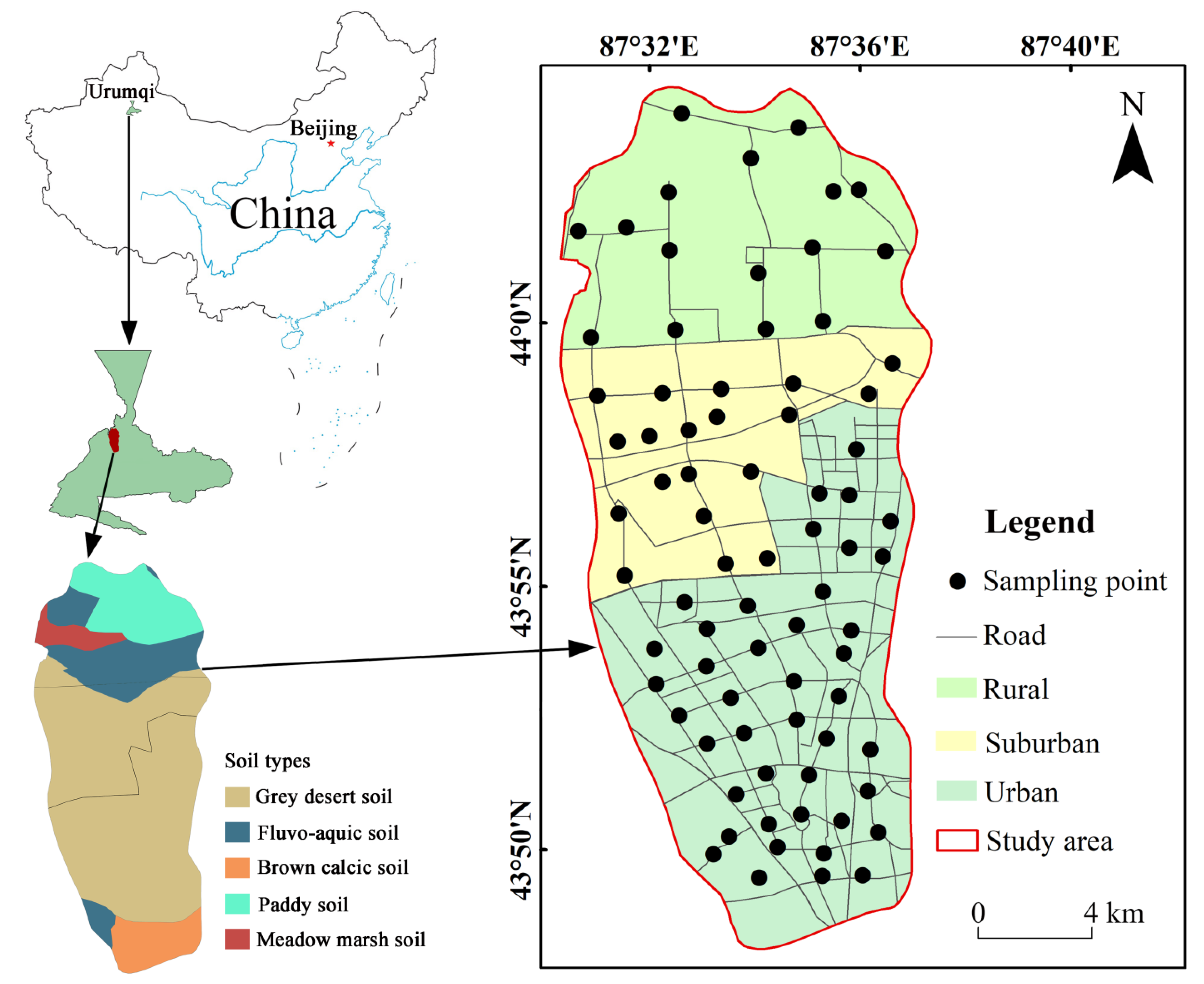
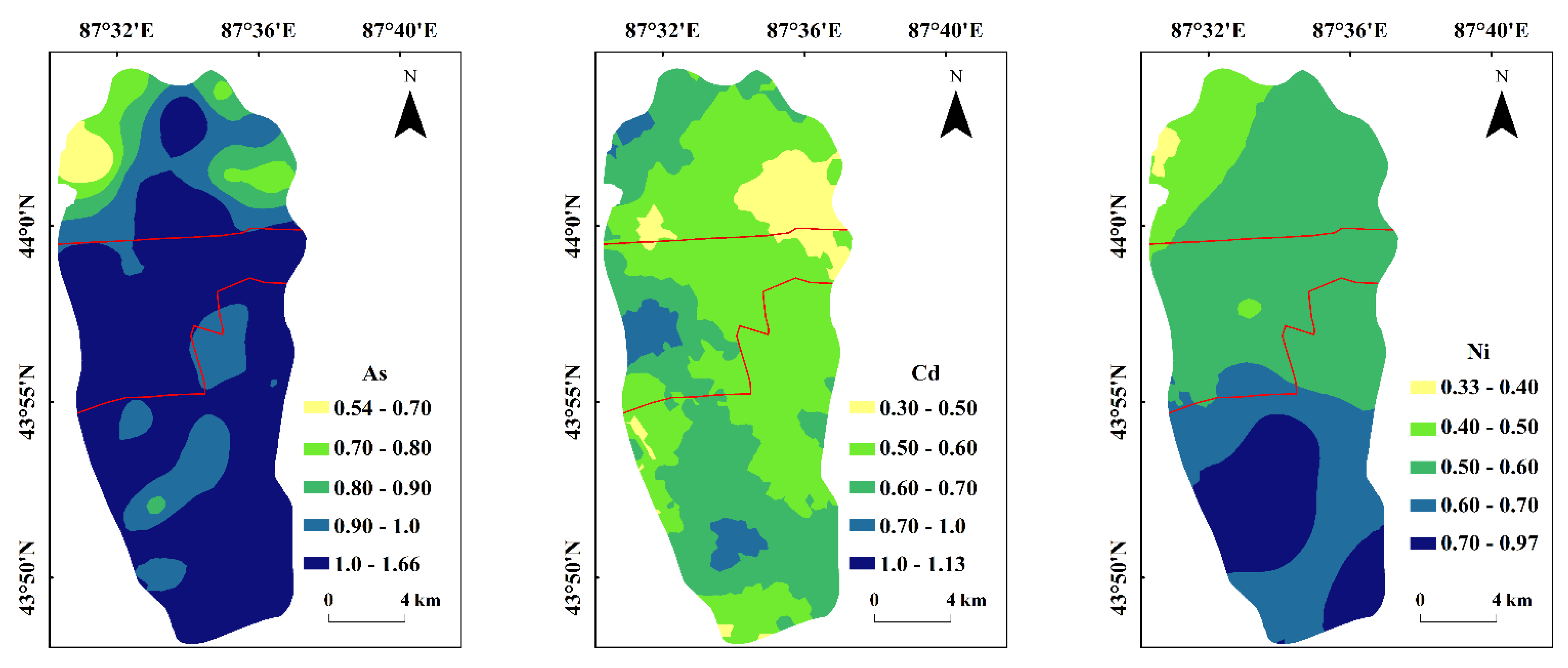
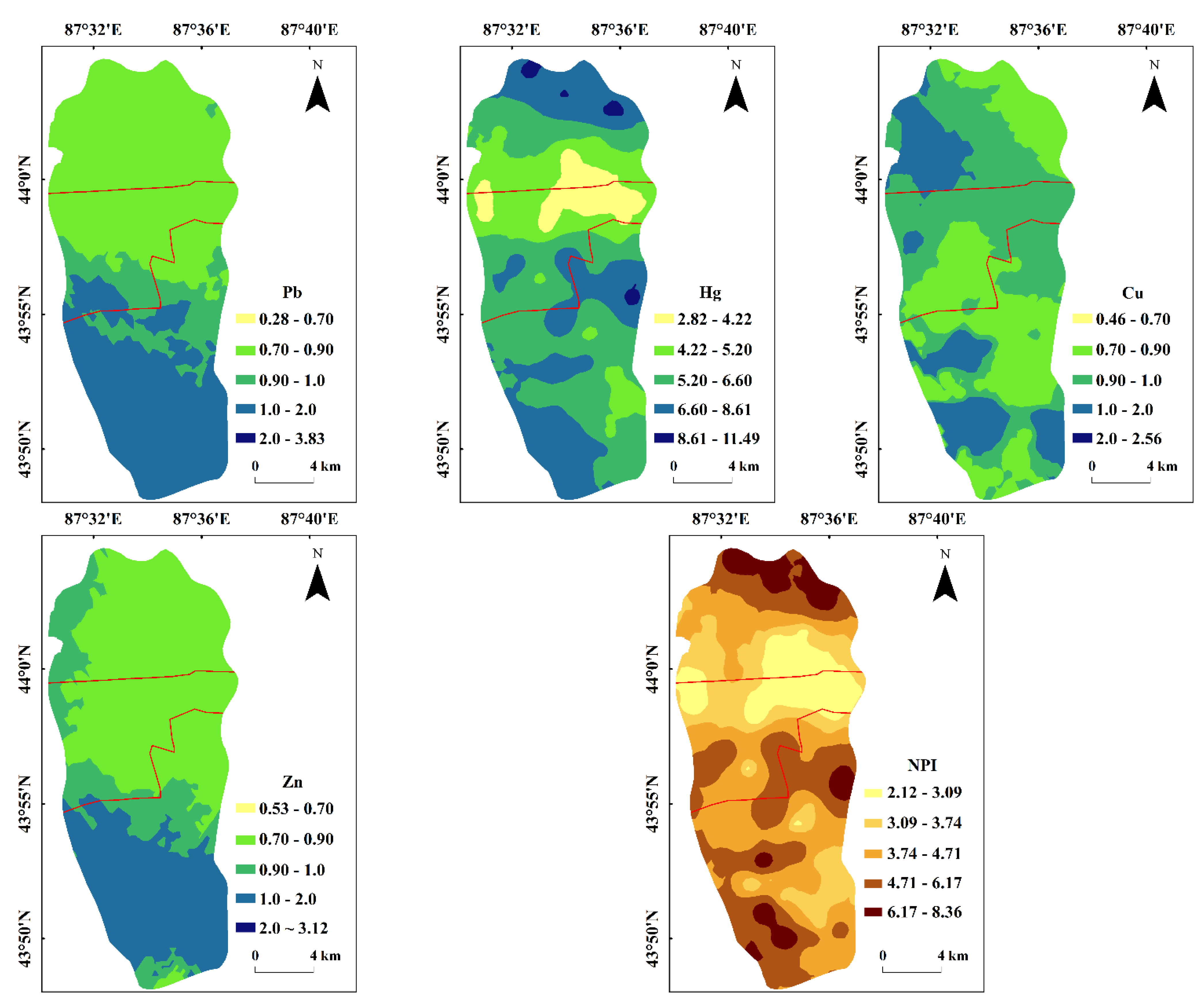
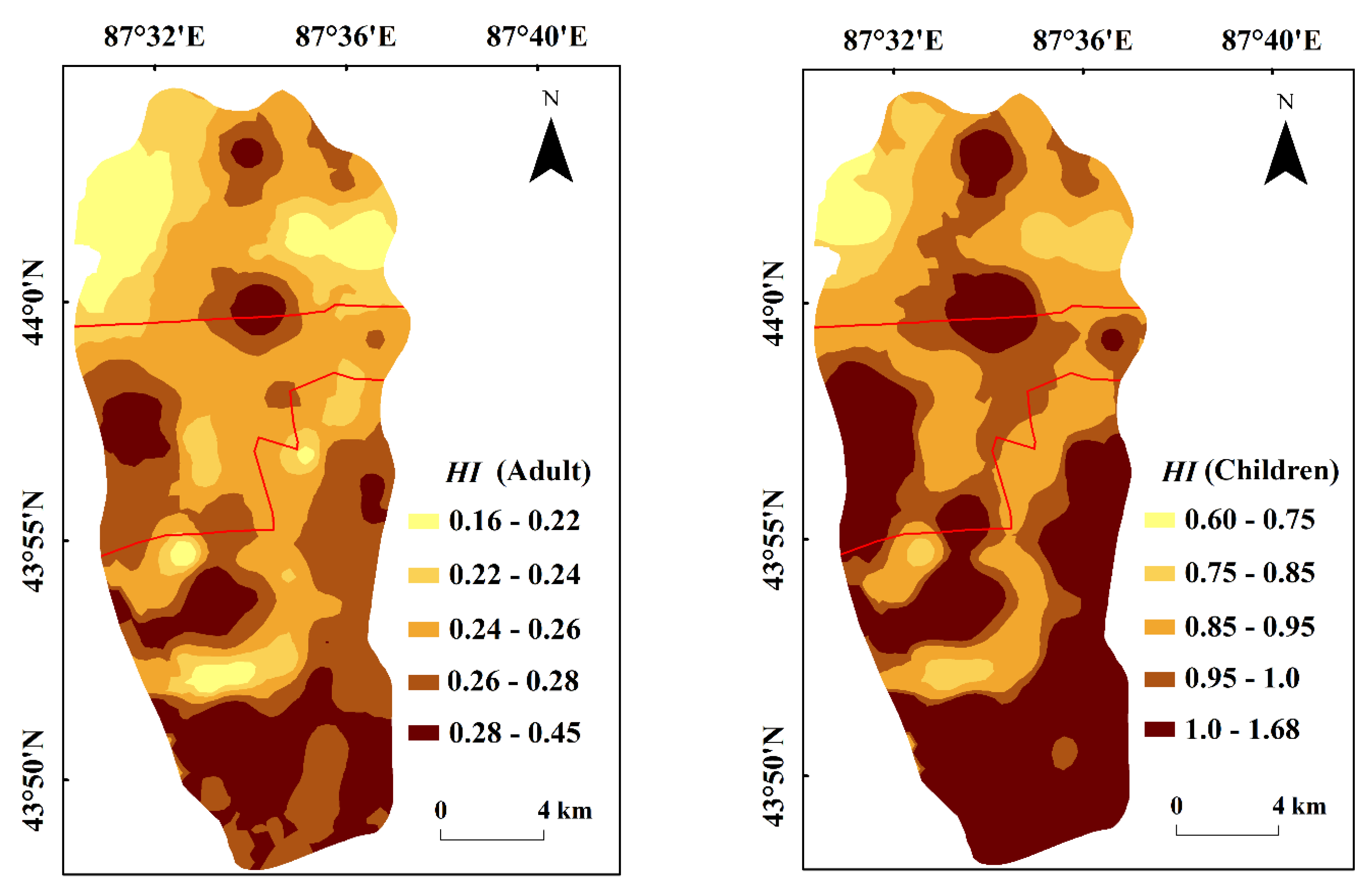
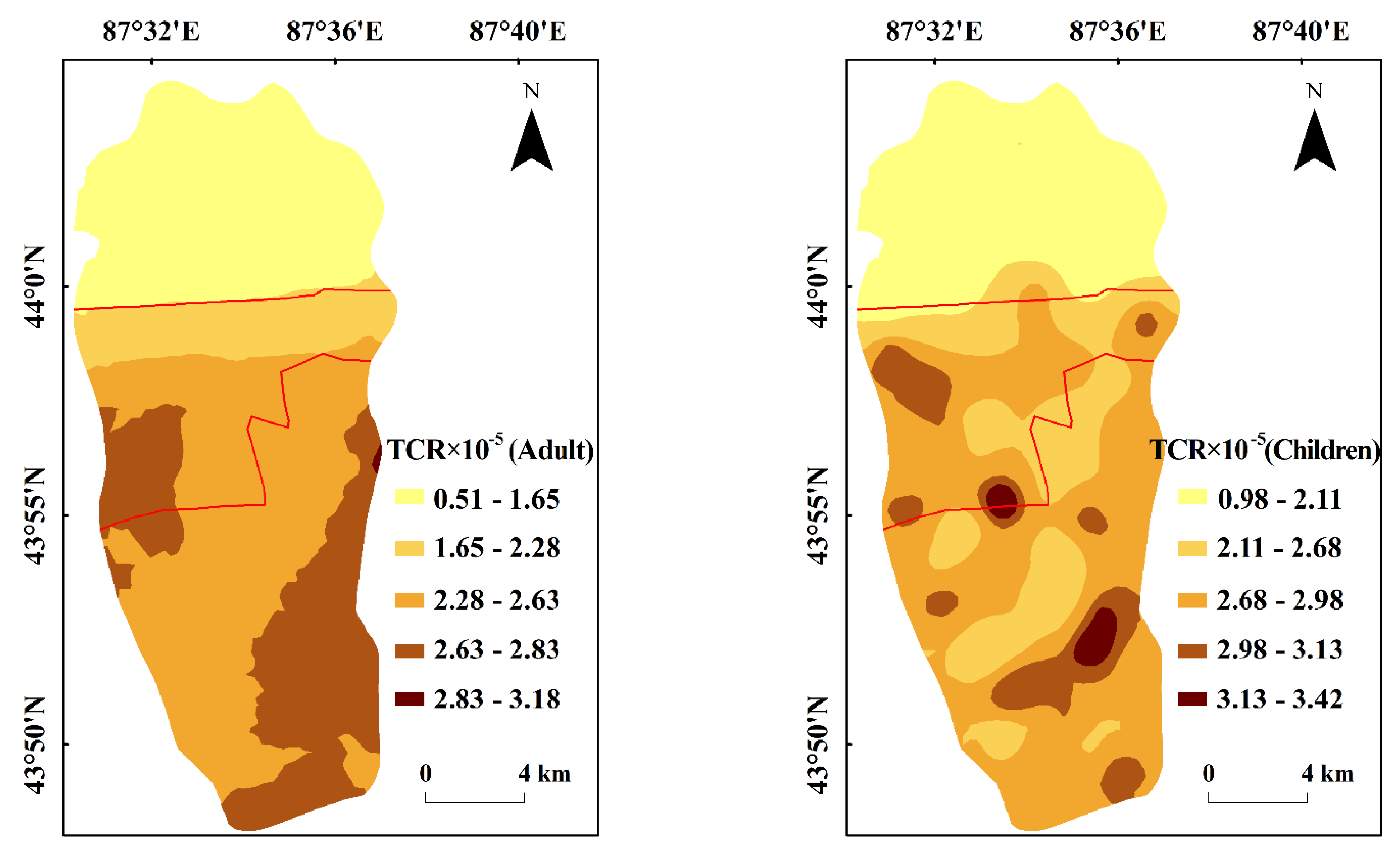
| Factor | Meaning and Units | Values | |
|---|---|---|---|
| Adult | Children | ||
| IngR | Dust ingestion rate (mg/d) | 100 | 200 |
| InhR | Dust inhalation rate (m3/d) | 20 | 7.65 |
| CF | Unit conversion factor (kg/mg) | 1 × 10−6 | 1 × 10−6 |
| EF | Exposure frequency (d/a) | 350 | 350 |
| ED | Exposure duration (year) | 24 | 6 |
| SA | Exposed skin area (cm2) | 0.153 | 0.086 |
| AF | Skin adherence factor (mg/cm2/d) | 0.49 | 0.65 |
| ABS | Dermal absorption factor (unitless) | 0.001 | 0.001 |
| PEF | Particle emission factor (m3/kg) | 1.36 × 109 | 1.36 × 109 |
| BW | Average body weight (kg) | 56.8 | 15.9 |
| ATnc | Average exposure time for non-carcinogens (d) | ED × 365 | ED × 365 |
| ATca | Average exposure time for carcinogens (d) | 70 × 365 | 70 × 365 |
| Elements | RfD | SF | ||||
|---|---|---|---|---|---|---|
| Ingest | Inhale | Dermal | Ingest | Inhale | Dermal | |
| As | 0.0003 | 0.30 | 0.000123 | 1.50 | 15.10 | 3.66 |
| Cd | 0.001 | 0.001 | 0.00001 | 6.10 | 6.30 | / |
| Ni | 0.02 | 0.0206 | 0.0054 | / | / | / |
| Pb | 0.0035 | 0.00352 | 0.000525 | / | / | / |
| Hg | 0.0003 | 0.0003 | 0.000024 | / | / | / |
| Cu | 0.040 | 0.040 | 0.012 | / | / | / |
| Zn | 0.30 | 0.30 | 0.06 | / | / | / |
| Gradients | Statistics | As | Cd | Ni | Pb | Hg | Cu | Zn |
|---|---|---|---|---|---|---|---|---|
| Urban (n = 42) | Minimum (mg/kg) | 7.79 | 0.07 | 14.00 | 4.00 | 0.25 | 11.00 | 42.0 |
| Maximum (mg/kg) | 12.60 | 0.24 | 29.00 | 54.00 | 0.87 | 61.50 | 200.00 | |
| Average (mg/kg) | 10.36 | 0.14 | 20.21 | 15.86 | 0.50 | 22.65 | 68.79 | |
| Median (mg/kg) | 10.30 | 0.14 | 20.00 | 14.00 | 0.45 | 21.70 | 59.00 | |
| St.D (mg/kg) | 1.05 | 0.04 | 2.97 | 8.82 | 0.17 | 8.21 | 31.99 | |
| CV | 0.10 | 0.29 | 0.15 | 0.56 | 0.34 | 0.36 | 0.47 | |
| Suburban (n = 19) | Minimum (mg/kg) | 9.70 | 0.08 | 11.0 | 8.0 | 0.23 | 15.0 | 34.0 |
| Maximum (mg/kg) | 12.70 | 0.22 | 22.0 | 17.0 | 0.75 | 27.10 | 76.0 | |
| Average (mg/kg) | 10.68 | 0.14 | 16.37 | 11.95 | 0.40 | 21.97 | 53.16 | |
| Median (mg/kg) | 10.30 | 0.12 | 16.0 | 12.0 | 0.39 | 22.50 | 52.0 | |
| St.D (mg/kg) | 0.86 | 0.05 | 2.54 | 2.01 | 0.15 | 3.06 | 10.58 | |
| CV | 0.08 | 0.36 | 0.16 | 0.17 | 0.38 | 0.14 | 0.20 | |
| Rural (n = 16) | Minimum (mg/kg) | 5.41 | 0.08 | 10.0 | 7.0 | 0.21 | 18.6 | 44.0 |
| Maximum (mg/kg) | 16.60 | 0.26 | 19.0 | 17.0 | 0.80 | 37.50 | 93.0 | |
| Average (mg/kg) | 9.18 | 0.13 | 15.31 | 11.56 | 0.46 | 22.57 | 55.69 | |
| Median (mg/kg) | 9.39 | 0.13 | 16.0 | 12.0 | 0.40 | 21.90 | 52.0 | |
| St.D (mg/kg) | 2.65 | 0.05 | 2.73 | 2.25 | 0.21 | 4.48 | 12.42 | |
| CV | 0.29 | 0.38 | 0.18 | 0.19 | 0.46 | 0.20 | 0.22 | |
| Background values in soil in Urumqi (mg/kg) | 9.99 | 0.23 | 29.90 | 14.10 | 0.076 | 24.00 | 64.20 | |
| Gradients | Statistics | Pi | NPI | ||||||
|---|---|---|---|---|---|---|---|---|---|
| As | Cd | Ni | Pb | Hg | Cu | Zn | |||
| Urban (n = 42) | Minimum | 0.78 | 0.30 | 0.47 | 0.28 | 3.33 | 0.46 | 0.65 | 2.46 |
| Maximum | 1.26 | 1.04 | 0.97 | 3.83 | 11.49 | 2.56 | 3.12 | 8.36 | |
| Average | 1.04 | 0.61 | 0.68 | 1.13 | 6.56 | 0.94 | 1.07 | 4.85 | |
| Suburban (n = 19) | Minimum | 0.97 | 0.35 | 0.37 | 0.57 | 3.00 | 0.63 | 0.53 | 2.24 |
| Maximum | 1.27 | 0.96 | 0.74 | 1.21 | 9.86 | 1.13 | 1.18 | 7.16 | |
| Average | 1.07 | 0.59 | 0.55 | 0.85 | 5.27 | 0.92 | 0.83 | 3.87 | |
| Rural (n = 16) | Minimum | 0.54 | 0.35 | 0.33 | 0.50 | 2.82 | 0.78 | 0.69 | 2.12 |
| Maximum | 1.66 | 1.13 | 0.64 | 1.21 | 10.46 | 1.56 | 1.45 | 7.55 | |
| Average | 0.92 | 0.57 | 0.51 | 0.82 | 6.10 | 0.94 | 0.87 | 4.45 | |
| Gradient | Element | HQingest | HQinhale | HQdermal | HQ | HI | |||||
|---|---|---|---|---|---|---|---|---|---|---|---|
| Adults | Children | Adults | Children | Adults | Children | Adults | Children | Adults | Children | ||
| Urban (n = 42) | As | 5.83 × 10−2 | 4.17 × 10−1 | 8.58 × 10−9 | 1.17 × 10−8 | 1.07 × 10−1 | 2.84 × 10−1 | 1.65× 10−1 | 7.01× 10−1 | 0.26 | 1.02 |
| Cd | 2.36 × 10−4 | 1.69 × 10−3 | 3.48 × 10−8 | 4.75 × 10−8 | 1.77 × 10−2 | 4.72 × 10−2 | 1.80× 10−2 | 4.89× 10−2 | |||
| Ni | 1.71 × 10−3 | 1.22 × 10−2 | 2.44 × 10−7 | 3.33 × 10−7 | 4.74 × 10−3 | 1.26 × 10−2 | 6.44 × 10−3 | 2.48× 10−2 | |||
| Pb | 7.65 × 10−3 | 5.47 × 10−2 | 1.12 × 10−6 | 1.53 × 10−6 | 3.82 × 10−2 | 1.02 × 10−1 | 4.59× 10−2 | 1.57× 10−1 | |||
| Hg | 2.80 × 10−3 | 2.00 × 10−2 | 4.12 × 10−7 | 5.64 × 10−7 | 2.63 × 10−2 | 7.00 × 10−2 | 2.91 × 10−2 | 9.00 × 10−2 | |||
| Cu | 9.56 × 10−4 | 6.83 × 10−3 | 1.41 × 10−7 | 1.92 × 10−7 | 2.39 × 10−3 | 6.36 × 10−3 | 3.34 × 10−3 | 1.32 × 10−2 | |||
| Zn | 3.87 × 10−4 | 2.77 × 10−3 | 5.69 × 10−8 | 7.78 × 10−8 | 1.45 × 10−3 | 3.86 × 10−3 | 1.84 × 10−3 | 6.63 × 10−3 | |||
| Suburban (n = 19) | As | 6.01 × 10−2 | 4.29 × 10−1 | 8.83 × 10−9 | 1.21 × 10−8 | 1.10 × 10−1 | 2.93 × 10−1 | 1.70 × 10−1 | 7.22 × 10−1 | 0.25 | 0.99 |
| Cd | 2.30 × 10−4 | 1.64 × 10−3 | 2.85 × 10−8 | 4.62 × 10−8 | 1.72 × 10−2 | 4.59 × 10−2 | 1.75 × 10−2 | 4.76 × 10−2 | |||
| Ni | 1.38 × 10−3 | 9.87 × 10−3 | 1.97 × 10−7 | 2.70 × 10−7 | 3.84 × 10−3 | 1.02 × 10−2 | 5.22 × 10−3 | 2.01 × 10−2 | |||
| Pb | 5.76 × 10−3 | 4.12 × 10−2 | 8.43 × 10−7 | 1.15 × 10−6 | 2.88 × 10−2 | 7.67 × 10−2 | 3.46 × 10−2 | 1.18 × 10−1 | |||
| Hg | 2.25 × 10−3 | 1.61 × 10−2 | 3.32 × 10−7 | 4.53 × 10−7 | 2.11 × 10−2 | 5.63 × 10−2 | 2.34 × 10−2 | 7.24 × 10−2 | |||
| Cu | 9.27 × 10−4 | 6.63 × 10−3 | 1.36 × 10−7 | 1.86 × 10−7 | 2.32 × 10−3 | 6.17 × 10−3 | 3.25 × 10−3 | 1.28 × 10−2 | |||
| Zn | 2.99 × 10−4 | 2.14 × 10−3 | 4.40 × 10−8 | 6.01 × 10−8 | 1.12 × 10−3 | 2.99 × 10−3 | 1.42 × 10−3 | 5.12 × 10−3 | |||
| Rural (n = 16) | As | 5.17 × 10−2 | 3.69 × 10−1 | 7.60 × 10−9 | 1.04 × 10−8 | 9.45 × 10−2 | 2.52 × 10−1 | 1.46 × 10−1 | 6.21 × 10−1 | 0.23 | 0.90 |
| Cd | 2.22 × 10−4 | 1.58 × 10−3 | 3.26 × 10−8 | 4.45 × 10−8 | 1.66 × 10−2 | 4.42 × 10−2 | 1.68 × 10−2 | 4.58 × 10−2 | |||
| Ni | 1.29 × 10−3 | 9.23 × 10−3 | 1.85 × 10−7 | 2.52 × 10−7 | 3.59 × 10−3 | 9.56 × 10−3 | 4.88 × 10−3 | 1.88 × 10−2 | |||
| Pb | 5.58 × 10−3 | 3.98 × 10−2 | 8.16 × 10−7 | 1.11 × 10−6 | 2.79 × 10−2 | 7.42 × 10−2 | 3.35 × 10−2 | 1.14 × 10−1 | |||
| Hg | 2.61 × 10−3 | 1.86 × 10−2 | 3.84 × 10−7 | 5.24 × 10−7 | 2.44 × 10−2 | 6.51 × 10−2 | 2.71 × 10−2 | 8.38 × 10−2 | |||
| Cu | 9.53 × 10−4 | 6.81 × 10−3 | 1.40 × 10−7 | 1.91 × 10−7 | 2.38 × 10−3 | 6.34 × 10−3 | 3.33 × 10−3 | 1.31 × 10−2 | |||
| Zn | 3.13 × 10−4 | 2.24 × 10−3 | 4.61 × 10−8 | 6.30 × 10−8 | 1.17 × 10−3 | 3.13 × 10−3 | 1.49 × 10−3 | 5.37 × 10−3 | |||
| Gradient | Element | CRingest | CRinhale | CRdermal | CR | TCR | |||||
|---|---|---|---|---|---|---|---|---|---|---|---|
| Adults | Children | Adults | Children | Adults | Children | Adults | Children | Adults | Children | ||
| Urban (n = 42) | As | 9.00 × 10−6 | 1.61 × 10−5 | 1.33 × 10−8 | 4.55 × 10−9 | 1.65 × 10−5 | 1.10 × 10−5 | 2.55 × 10−5 | 2.70 × 10−5 | 2.60 × 10−5 | 2.79 × 10−5 |
| Cd | 4.94 × 10−7 | 8.83 × 10−7 | 7.51 × 10−11 | 2.56 × 10−11 | / | / | 4.94 × 10−7 | 8.83 × 10−7 | |||
| Suburban (n = 19) | As | 9.27 × 10−6 | 1.66 × 10−5 | 1.37 × 10−8 | 4.69 × 10−9 | 1.70 × 10−5 | 1.13 × 10−5 | 2.62 × 10−5 | 2.79 × 10−5 | 2.66 × 10−5 | 2.88 × 10−5 |
| Cd | 4.81 × 10−7 | 8.59 × 10−7 | 7.31 × 10−11 | 2.50 × 10−11 | / | / | 4.05 × 10−7 | 8.59 × 10−7 | |||
| Rural (n = 16) | As | 7.97 × 10−6 | 1.42 × 10−5 | 8.48 × 10−9 | 2.90 × 10−9 | 5.29 × 10−13 | 1.16 × 10−6 | 7.98 × 10−6 | 1.54 × 10−5 | 8.44 × 10−6 | 1.62 × 10−5 |
| Cd | 4.63 × 10−7 | 8.28 × 10−7 | 5.06 × 10−11 | 1.73 × 10−11 | / | / | 4.63 × 10−7 | 8.28 × 10−7 | |||
Publisher’s Note: MDPI stays neutral with regard to jurisdictional claims in published maps and institutional affiliations. |
© 2022 by the authors. Licensee MDPI, Basel, Switzerland. This article is an open access article distributed under the terms and conditions of the Creative Commons Attribution (CC BY) license (https://creativecommons.org/licenses/by/4.0/).
Share and Cite
Sidikjan, N.; Eziz, M.; Li, X.; Wang, Y. Spatial Distribution, Contamination Levels, and Health Risks of Trace Elements in Topsoil along an Urbanization Gradient in the City of Urumqi, China. Sustainability 2022, 14, 12646. https://doi.org/10.3390/su141912646
Sidikjan N, Eziz M, Li X, Wang Y. Spatial Distribution, Contamination Levels, and Health Risks of Trace Elements in Topsoil along an Urbanization Gradient in the City of Urumqi, China. Sustainability. 2022; 14(19):12646. https://doi.org/10.3390/su141912646
Chicago/Turabian StyleSidikjan, Nazupar, Mamattursun Eziz, Xinguo Li, and Yonghui Wang. 2022. "Spatial Distribution, Contamination Levels, and Health Risks of Trace Elements in Topsoil along an Urbanization Gradient in the City of Urumqi, China" Sustainability 14, no. 19: 12646. https://doi.org/10.3390/su141912646
APA StyleSidikjan, N., Eziz, M., Li, X., & Wang, Y. (2022). Spatial Distribution, Contamination Levels, and Health Risks of Trace Elements in Topsoil along an Urbanization Gradient in the City of Urumqi, China. Sustainability, 14(19), 12646. https://doi.org/10.3390/su141912646







